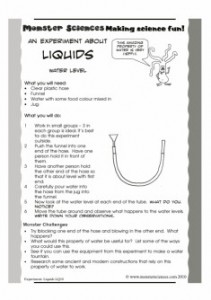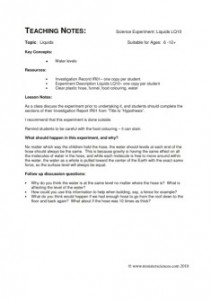Investigate how gravity affects water by making and testing a water level.
 |
 |
An experiment about Liquids: Make a water level
What you will need:
- Clear plastic hose
- Funnel
- Water with some food colour mixed in
- Jug
What you will do:
1 Work in small groups – 3 in each group is ideal. It’s best to do this experiment outside.
2 Push the funnel into one end of the hose. Have one person hold it in front of them.
3 Have another person hold the other end of the hose so that it is about level with first end.
4 Carefully pour water into the hose from the jug into the funnel.
5 Now look at the water level at each end of the tube. What do you notice?
6 Move the tube around and observe what happens to the water levels. Write down your observations.
Monster Challenges:
- Try blocking one end of the hose and blowing in the other end. What happens?
- What would this property of water be useful for? List some of the ways you could use this.
- See if you can use the equipment from this experiment to make a water fountain.
- Research some ancient and modern constructions that rely on this property of water to work.
Teaching Notes: Monster Sciences Experiment: Liquids LQ10
Topic:
Liquids
Key Concepts:
Water levels
Resources:
- Investigation Record IR01– one copy per student
- Experiment Description Liquids LQ10– one copy per student
- Clear plastic hose, funnel, food colouring, water
Lesson Notes:
As a class discuss the experiment prior to undertaking it, and students should complete the sections of their Investigation Report IR01 from ”Title to “Hypothesis”.
I recommend that this experiment is done outside.
Remind students to be careful with the food colouring – it can stain.
What should happen in this experiment, and why?
No matter which way the children hold the hose, the water should levels at each end of the hose should always be the same. This is because gravity is having the same effect on all the molecules of water in the hose, and while each molecule is free to move around within the water, the water as a whole is pulled toward the center of the Earth with the exact same force, so the surface level will always be equal.
Follow up discussion questions:
- Why do you think the water is at the same level no matter where the hose is? What is affecting the level of the water?
- How could you use this information to help when building, say, a fence for example?
- What do you think would happen if we had enough hose to go from the roof down to the floor and back again? What about if the hose was 10 times as thick?



